
Physalaemus nattereri is a frog native to central and southeastern Brazil and eastern Bolivia and Paraguay.

Physalaemus is a large genus of leptodactylid frogs. These frogs, sometimes known as dwarf frogs or foam frogs, are found in South America. It is very similar to Leptodactylus, a close relative, and indeed the recently described Leptodactylus lauramiriamae is in some aspects intermediate between them.
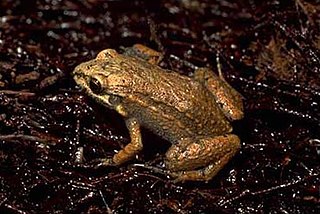
Adenomera araucaria is a species of frog in the family Leptodactylidae. It is endemic to southern Brazil, where it occurs in the southern part of the Serra Geral in the states of Santa Catarina and Rio Grande do Sul.

Hylodes sazimai is a species of frog in the family Hylodidae. It is endemic to Brazil. Its natural habitats are subtropical or tropical moist lowland forest, subtropical or tropical moist montane forest, and rivers. It is threatened by habitat loss.
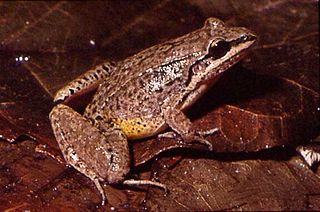
Leptodactylus notoaktites is a species of frog in the family Leptodactylidae. It is endemic to southeastern Brazil and is known from the states of Santa Catarina, Paraná, and São Paulo state. Common name Iporanga white-lipped frog has been coined for it.

Leptodactylus spixi is a species of frog in the family Leptodactylidae. It is endemic to eastern Brazil and occurs in the Atlantic forests of the Bahia, Espírito Santo, and Rio de Janeiro states. The specific name spixi honors Johann Baptist von Spix, a German naturalist who worked in Brazil. Prior to its description, this species had been referred to as Leptodactylus mystaceus(Spix, 1824). Common name Spix's white-lipped frog has been coined for this species.
Phrynopus dagmarae is a species of frog in the family Strabomantidae. It is endemic to the Andes of Peru and only known from the Pachitea and Ambo Provinces in the Huánuco Region, from near the type locality. The specific name dagmarae honors Dagmar Schramm from Germany.
Physalaemus aguirrei is a species of frog in the family Leptodactylidae. It is endemic to eastern Brazil and occurs in the southern Bahia, northern Espírito Santo and northeastern Minas Gerais. The specific name aguirrei honours Alvaro Coutinho Aguirre, a Brazilian zoologist. However, common name Linhares dwarf frog has been proposed for it.
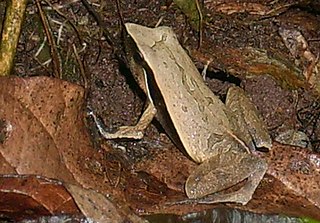
Physalaemus albonotatus is a species of frog in the family Leptodactylidae. It is found in Brazil, Paraguay, and Chacoan Argentina and Bolivia.
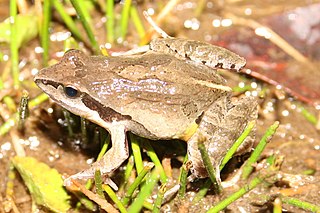
Physalaemus barrioi is a species of frog in the family Leptodactylidae. It is endemic to Serra do Bocaina in São Paulo state, Brazil. The specific name barrioi honors Avelino Barrio, a Spanish botanist and zoologist who lived in Argentina. However, the common name Bocaina dwarf frog has been proposed for it.
Physalaemus deimaticus is a species of frog in the family Leptodactylidae. It is endemic to Brazil and only known from its type locality in Jaboticatubas, Serra do Cipó, Minas Gerais. The specific name deimaticus is derived from Greek deimos fror "fear" and refers to the defensive display of this frog, probably aimed at scaring predators. Common names Jaboticatubas dwarf frog and frightening foam froglet have been coined for it.

Physalaemus ephippifer is a species of frog in the family Leptodactylidae. It is found in central and eastern Brazilian Amazonia, the Guianas, and southern Venezuela. It might not occur in French Guiana.
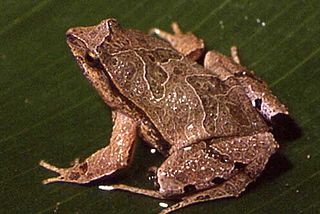
Physalaemus maculiventris is a species of frog in the family Leptodactylidae. It is endemic to Southeast and South Brazil and is known primarily from the Serra do Mar in Espírito Santo, Rio de Janeiro, São Paulo state, Paraná, and Santa Catarina states. Common name Mantagnes dwarf frog has been proposed for it.
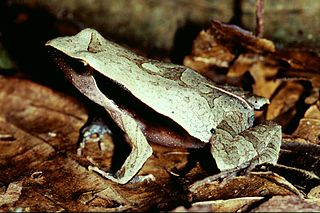
Physalaemus olfersii is a species of frog in the family Leptodactylidae. It is endemic to southeastern Brazil and is known from Espírito Santo, southeastern Minas Gerais, and São Paulo states. Records further south refer to Physalaemus lateristriga, which was restored from the synonymy of Physalaemus olfersii in 2010. Common name Atlantic Forest dwarf frog has been proposed for this species.

Proceratophrys schirchi is a species of frog in the family Odontophrynidae. It is endemic to eastern Brazil and occurs in southeastern Bahia, Espírito Santo, northeastern Minas Gerais, and Rio de Janeiro states. The specific name schirchi honours Paulo F. Schirch, a Brazilian zoologist who collected the type series. Common names Santo smooth horned frog and Brazilian smooth horned frog can refer to this species, the latter specifically referring to Proceratophrys precrenulata that is now considered a junior synonym only.

Chiasmocleis cordeiroi is a species of frog in the family Microhylidae. It is endemic to Bahia in eastern Brazil. It is known from Camamu, its type locality, and from few other localities on both sides of the De Contas River. The specific name cordeiroi honors Paulo Henrique Chaves Cordeiro, a Brazilian biologist. Common name Cordeiro's humming frog has been coined for this species.

Chiasmocleis crucis is a species of frog in the family Microhylidae. It is endemic to Bahia in eastern Brazil. It is known from Camamu, its type locality, and from the Serra Bonita Private Reserve of Natural Heritage in Camacan/Pau Brasil. The specific name crucis honors Carlos Alberto Gonçalves da Cruz, a Brazilian herpetologist.

Stereocyclops histrio is a species of frog in the family Microhylidae. It is endemic to the northeastern Bahia state of Brazil where it occurs in remnants of the Atlantic forest. After the holotype was collected in 1944, the species went unrecorded until a population was found in the Una Biological Reserve and its surroundings in 1999. It is now known from four locations. Common name Bahia yellow frog has been coined for it, perhaps in reference to the bright lemon yellow coloration of the holotype. It was the only species in the genus Hyophryne until 2012 when molecular data demonstrated that it is nested within Stereocyclops species.

Adenomera saci is a species of frog in the family Leptodactylidae. It is endemic to central-western and northern Brazil. Prior to its description by Carvalho and Giaretta in 2013, it was confused with Adenomera martinezi. The specific name saci is Portuguese word for a kind of whistling imp in Brazilian (Tupi) folklore, in allusion to the whistling call of this frog.
Physalaemus insperatus is a species of frog in the family Leptodactylidae. It is endemic to southern Brazil and is only known from its type locality, Serra da Pedra Branca do Araraquara in Guaratuba, Paraná. The specific name insperatus means "unexpected" or "surprising" in Latin and alludes to the fortuitous finding of a new species among old museum specimens, originally identified as Physalaemus olfersii; taxonomically, it is part of the so-called Physalameus olfersii species group.

















